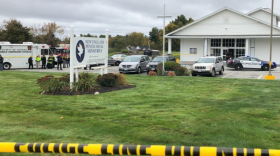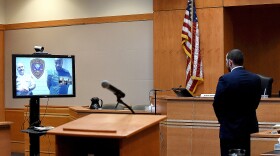There are old pinball machines and arcade cabinets littered here and there in dive bars and restaurants all across the country.
But have you ever considered what it takes to maintain and repair them? I have.
My first job was at the six-screen theater in Keene, New Hampshire. I applied on my16th birthday. The free movies were an obvious perk, but even better was the pinball.
My coworkers and I played on breaks, or after hours. Once I had a key, I even used to skip school to hit the flippers.
By senior year, I was probably depositing half my meager paycheck back to my bosses, two quarters at a time.
I’m telling you this so you can understand my excitement, when I stepped inside My Arcade Repair in Pelham New Hampshire.
My Arcade Repair is housed in a three-story (including the basement) multi-car garage.
Throughout the building, the gutted corpses of ancient gaming cabinets are frozen in states of half-reanimation.
Piles of circuit boards the size of cafeteria trays lay strewn about like old newspapers across nearly every available surface.
On one workshop table, widgets of some kind fill plastic containers that once held cherry-red ring pops and Twizzlers.

It’s an alternate universe, a pet-cemetary for vintage video games, a post-apocalyptic episode of Stranger Things. And the Dr. Frankenstein of this laboratory is Sarah St. John.
“It’s like a Willy Wonka factory for pinball nerds,” I exclaim.
“Pinball Nerds, video-game nerds, and jukebox nerds.”
Sarah is about six feet tall. She’s sporting blonde bangs, and wears a plain black t-shirt. She looks like she might be into heavy metal, or maybe Pink Floyd.
She tells me that she first started fixing arcade machines back in the 1980's.
“Every two or three days, the cash box were overflowing with quarters, and the quarters would fall on the fuse holders. So the machines weren’t breaking down. They were just overloaded with quarters back in the ‘80s.”
Sarah says she came into the trade at the perfect time. The old-timers she worked with at a vending machine company back then taught her to fix all of the old, mechanical games. She, with a newly minted electronic engineering degree, could tackle the new fancy video games.
I asked her how the landscape has shifted over these past three decades.
“What I’m finding is that a lot more people have either inherited machines or can afford machines right now,” she tells me. “It’s a lot of nostalgia for people in their 50's, and 60's… and they want man-caves.”

If I had to guess, I would have thought the arcade repair economy would be pretty tight in 2018. I pictured Sarah having to travel miles driving from rural town to rural town, attending to dive bar machines for relatively low-paying patch jobs.
After all, how much can you make fixing games that only take in fifty cents at a time?
But think about it: who can afford to keep up a menagerie of vintage arcade games? The collectors. That’s who.
For Sarah, who can rebuild an old machine from the ground-up the way a custom mechanic can build a new hot-rod, it's a welcome development.
She points to a pinball machine that’s folded up like a laptop to one side of her workshop.
“Addams Family [pinball machine] for example… About 10 years ago I couldn’t sell them for $1,200. And today they’re going for $7,000 to $8,000 dollars."
Talk about hitting the jackpot.
In order to service the region’s arcade buffs without having to scrounge Ebay for parts, Sarah has turned a whole floor of her garage into a junkyard, circa 1980.
Rows of smudgy, grey, cathode-ray tube TV monitors stretch back into the darkness. There’s so much inventory there, I have trouble snaking my way through for fear of stepping on something of unknown value.
“The basement has huge amount of circuit boards that are no longer available,” Sarah says, pointing towards racks. “So what I do is, whenever a machine gets destroyed because of water damage, everything gets gutted out of them.”

Sarah tells me she had to clean out several dying Radio Shacks in order to gather such a massive collection of in-house parts.
She even bought their shelving - so she could organize this graveyard into something useful.
She pulls out drawer after drawer in one of the many ceiling high units to show me all of the bits and bobbles that make up a pinball machine: brackets, targets, play-field posts, relays, slingshots, plungers, rings and light bulbs.
“It’s a huge operation,” she says.
Upstairs, in a space that could easily fit an in-law apartment, is a room that looks like a prop department for a movie about NASA’s Apollo program.
The walls are lined with maybe a dozen testing units: big flashy consoles, where Sarah can plug in the brains of a pinball machine (the board) and test its circuitry.
“So you can read this thing?” I ask her.
“Yeah I can pretend the door is open. I can go into the service menu, I can do some diagnostics… I can test some switches.”
“You can’t fix any high scores can you?”
She hesitates.
“I can get into the memory chips.”
“Dangerous.”
“Yes, I am.”
Apparently, Sarah isn’t the only dangerous thing at her workshop. The games themselves, left to rot in basements all across New England, can pose their own kind of threat. Sarah says that just the day before, she was working on an old Tron pinball machine when the power supply went up in smoke.
In her main workshop area, the least cluttered part of My Arcade Repair, an old Tapper cabinet stands off to one side. In the center of the room, three pinball machines stand shoulder-to-shoulder.
One of them is Bally’s 1976 machine called Freedom.
Its play-board is propped up like the hood of a car, revealing the mechanical guts that live hidden inside.
“In the process of fixing these machines I’m guessing you get to play them?” I ask her.
“They call that testing. So, yes.”

Rather than boot up one of these machines, Sarah shows me a few of her own, lined up In a separate secret spot that I promised I wouldn’t reveal.
One of them is my all-time pinball machine favorite: the 1997 hit Medieval Madness, featuring voice work from SNL alum Tina Fey. She turns it on, pulls the plunger, and smacks a silver ball onto the play-field.
“If you look at this machine.. It’s very well-lit. It’s very clean. It plays fast. The flippers are great.”
Unlike the beat-up ones from her workshop that she’s still refurbishing, this machine is in flawless condition.
It’s so beautiful that when Sarah offers to let me “test” it for myself, I pass up the opportunity. I honestly can’t tell you what I was thinking. I guess some jackpots are best left to the pros.






